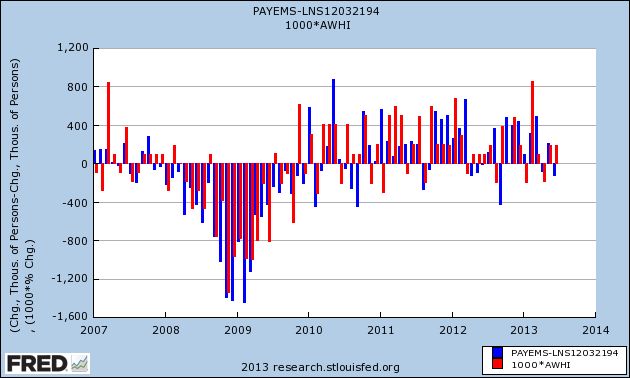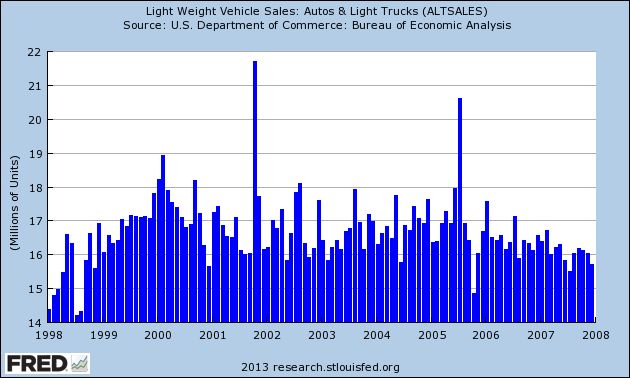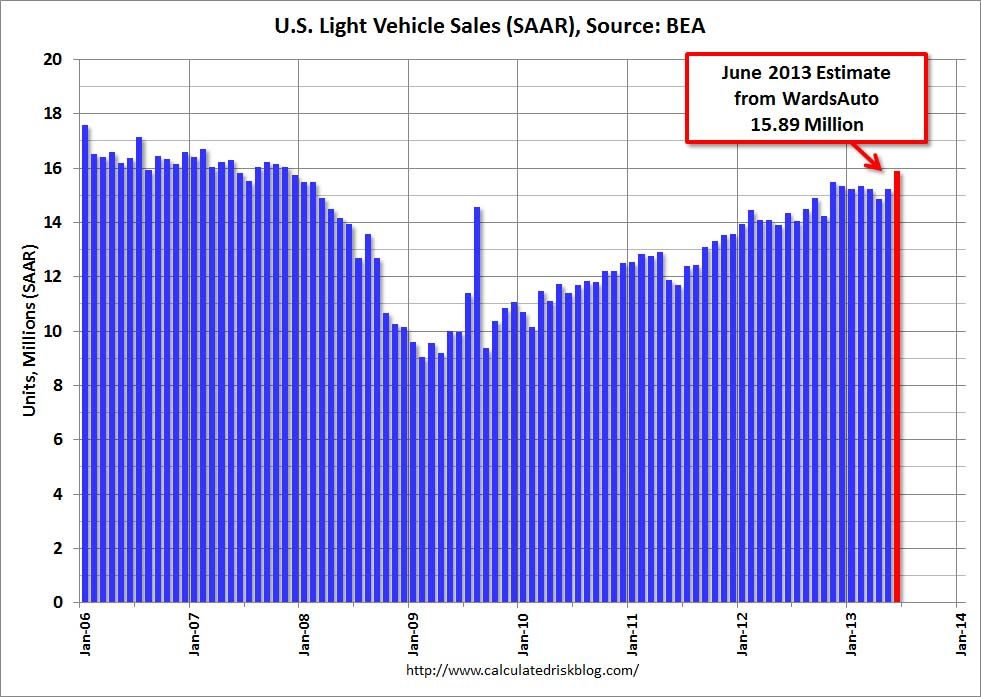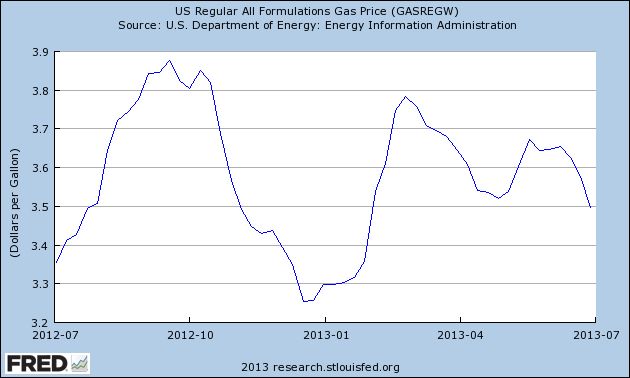- by New Deal democrat
Monthly data reported in the last week was all positive. Only ISM services declined - to a less expansionary reading. Construction spending and factory orders for May were up, as were ISM manufacturing (which went from contraction to expansion) and vehicle sales (which reached a 5 year record) for June. June payrolls were also up, as were aggregate hours worked. Unemployment was unchanged.
The big story among the
high frequency weekly indicators this week was a spike in the price of Oil, so let's start with that:
Oil prices and usage
- Oil $103.22 up +$6.66 w/w
- Gas $3.50 down -$0.07 w/w
- Usage 4 week average YoY unchanged
The price of Oil increased sharply this week to a new 52 week high. Apparently this was due to civil strife in Egypt - which is the only country in the middle east that does
NOT have Oil! There seems to be no sign of the strife spreading, so I have no idea what is going through traders' minds. The price of a gallon of gas fell in June, but is not at year lows. This will probably turn around shortly. The 4 week average for gas usage was unchanged.
Interest rates and credit spreads
- 5.42% BAA corporate bonds up +0.19%
- 2.55% 10 year treasury bonds up +0.22%
- 2.87% credit spread between corporates and treasuries down -0.03%
Interest rates for corporate bonds had generally been falling since being just above 6% in January 2011, hitting a low of 4.46% in November 2012. Treasuries previously were at a 2.4% high in late 2011, falling to a low of 1.47% in July 2012, but have retreated back above that high. Spreads have varied between a high over 3.4% in June 2011 to a low under 2.75% in October 2012. After being close to that low 6 weeks ago, interest rate spreads backed up significantly but have now stabilized.
Housing metrics
Mortgage applications from the
Mortgage Bankers Association:
- -3% w/w purchase applications
- +12% YoY purchase applications
- -16% w/w refinance applications
Refinancing applications have decreased sharply in the last 6 weeks due to higher interest rates. Purchase applications have also declined from thier multiyear highs in April, although they continue to be quite positive YoY.
Housing prices
Housing prices bottomed at the end of November 2011 on Housing Tracker, and averaged an increase of +2.0% to +2.5% YoY during 2012. This weeks's YoY increase remained close to their new 6 year record.
Real estate loans, from the
FRB H8 report:
- -0.4% w/w
- up +0.4% YoY
- +2.3% from its bottom
Loans turned up at the end of 2011 and averaged about 1% gains YoY through most of 2012. In the last several months the comparisons have completely stalled, although this week was again positive YoY.
Money supply
M1
- -0.6% w/w
- -0.8% m/m
- +8.9% YoY Real M1
M2
- unchanged w/w
- +0.4% m/m
- +5.4% YoY Real M2
Real M1 made a YoY high of about 20% in January 2012 and eased off thereafter. Earlier this year it increased again but has backed off its highs. Real M2 also made a YoY high of about 10.5% in January 2012. Its subsequent low was 4.5% in August 2012. It increased slightly in the first few months of this year and has stabilized since.
Employment metrics
American Staffing Association Index
- 94 up 1 w/w, up +1.1% YoY
Initial jobless claims
- 343,000 down -3,000
- 4 week average 345,500 down -250
Tax Withholding
- $150.8 B for the month of June vs. $139.0 B last year, up +$11.8 B or +8.5%
- $152.5 B for the last 20 reporting days vs. $145.2 B last year, up $7.3 B or +5.0%
The ASA deteriorated to being flat or negative compared with last year in the last several months, although it rebounded slightly this week. Daily tax withholding was very weak compared with its YoY average comparison in the last 5 months. Initial claims remain within their recent range of between 325,000 to 375,000, and have flattened out just as they have in the last 3 springs and summers.
Transport
Railroad transport from the
AAR
- +2800 carloads up 1.0% YoY
- +3200 carloads or +1.9% ex-coal
- -3700 or -1.5% intermodal units
- -1100 or -0.2% YoY total loads
Shipping transport
Rail transport has been both positive and negative YoY in the last several months. This week it was negative once again. The Harpex index had been improving slowly from its January 1 low of 352, but has flattened out in the last 4 weeks. The Baltic Dry Index decreased this week but remains close to its 52 week high.
Consumer spending
Gallup's YoY comparisons are still very positive, but less so than they have been since last December. The ICSC varied between +1.5% and +4.5% YoY in 2012, while Johnson Redbook was generally below +3%. The ICSC was again below the lower part of that range this week, but Johnson Redbook has been close to the high end of its range.
Bank lending rates
The TED spread is still at the low end of its 3 year range. LIBOR rose slightly from its new 3 year low established three weeks ago.
JoC ECRI Commodity prices
- up 1.24 to 121.99 w/w
- +3.57 YoY
This week most of the indicators, including some very important ones, showed weakness. The only strong positives were housing prices, gas prices, bank lending rates, and YoY purchase mortgages. Weak positives included temporary staffing, jobless claims, and credit spreads. Consumer spending remains very positive, but less so than in the last 6 months. Tax withholding payments, while also positive, are also at among their worst YoY comparisons in 5 months.
Negatives include rail traffic, bond prices, refinancing and weekly purchase mortgages, and real estate loans w/w. Oil prices are of course very negative, activating the Oil choke collar for the first time in a long time.
The sharp rise in interest rates and the sharp decrease in mortgage refinancing have now been joined by a big spike in Oil prices, which will shortly be felt at the pump. The big coincident indicators of the economy, consumer spending and initial jobless claims are trending more weakly positive and sideways, respectively. They continue, however, to show no signs of rolling over into negativity.
Have a nice weekend.























